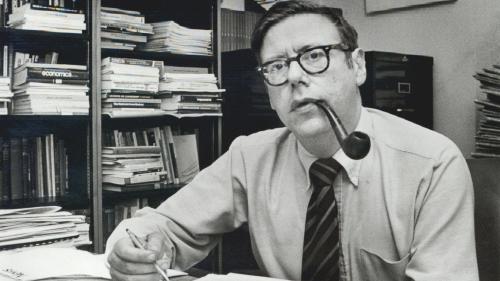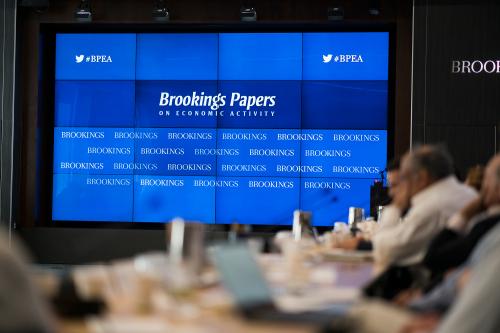YOUNGER READERS OF THIS volume may not appreciate how creative was the invention of the Brookings Papers on Economic Activity, how much it changed the way applied economics is communicated, and how magic has been its appeal to economists young and old, the novices and the famous, over its many years of operation. Within ten years of its creation, it had become one of the four most circulated academic journals in economics.
The Brookings Papers started at 1:30 p.m. on Thursday, April 16, 1970, with my first paper on the Phillips curve, which was discussed by none other than George Perry and Robert Solow. Right from the start, theBrookings Papers was the place to go to for up-to-date analysis of the macroeconomic puzzles of the day.
A scorecard of frequent contributors to the Brookings Papers over the years would include many of the great and famous economists of our day: not just Alan Greenspan and Ben Bernanke, but other luminaries including Olivier Blanchard, Rudiger Dornbusch, Stanley Fischer, Paul Krugman, Jeffrey Sachs, and Lawrence Summers, not to mention the Nobel Prize contingent of George Akerlof, Franco Modigliani, Edmund Phelps, Robert Solow, and James Tobin. It is a supreme tribute to Perry and Brainard—and to Arthur Okun, the journal’s cofounder with Perry—that, when they asked, these people came, whether they were famous then or would become so only later. They came because they appreciated the unique format and culture that is theBrookings Papers.
Part of that culture was in evidence at the conference dinner for this volume, namely, the after-dinner speakers, usually a surprise “mystery speaker.” The selection of these speakers was always bipartisan. Often they were Brookings Panel alumni who had braved the wars of inside-the administration Washington politics. Distinguished former and even current public officials such as Summers, Gregory Mankiw, and John Taylor were willing to go beyond cheerleading for their particular administration to discuss honestly some of the lessons they had learned from their mistakes—if not their policy mistakes, then at least their media mistakes. Mankiw’s entanglement in the issue of whether flipping hamburgers could be deemed a manufacturing activity is a memorable example.
It is worth recalling the original concept of the Brookings Papers. The publishing environment for the economics of policy analysis was a wasteland in the 1960s. Authors of scholarly papers had only two choices: refereed journals that often rejected policy-oriented papers as ephemeral, and conference volumes that took three years to be published and were often instantly obsolete. The genius of Okun and Perry was to create a new vision. No longer would authors wait three years for their papers to appear in print—and remember that print was “it,” the only way to communicate three decades before the invention of the Internet. Back in 1970 you couldn’t Google a topic. You couldn’t look up an NBER working paper in print, much less on the Web. The only way one kept up to date was by monitoring journals and conference volumes.
What an idea Okun and Perry had! Three-year publication lags were replaced by three months, and they really pulled it off. They also took the risk of starting with a small group of young people, most not even yet tenured, to provide sophisticated analysis of particular sectors of the economy.
The Brookings Papers’ conception was so compelling that it was very soon duplicated. The first to copy it was the Carnegie-Rochester Conference Series in 1973. Later came the International Seminar on Macroeconomics at the National Bureau of Economic Research in 1978, and then the NBER Macroeconomics Annual and Europe’s Economic Policy series in the mid-1980s.
A word about the Carnegie-Rochester series. In the 1970s and 1980s the evolution of macroeconomics was disrupted by the development of the “fooling model” of Robert Lucas and Thomas Sargent and then the real business cycle model of Finn Kydland and Edward Prescott. Twenty years ago Robert Hall brilliantly coined the metaphor of “freshwater versus saltwater” economics to describe this development, and he classified several economists according to their salinity, ranging from Sargent as “distilled water” to Okun as “the Salton Sea.” Okun, Perry, and Brainard were smart enough to stay entirely away from freshwater macroeconomics, leaving it to Carnegie-Rochester and others, and to recognize that the freshwater-saltwater distinction was irrelevant to many of the topics that they emphasized, including the rise and fall of the dollar in the 1980s, the fallout from the collapse of communism, and others.
My last theme involves a bit of archeology, to dig down to the initial conception of the Brookings Papers and highlight some major differences between that original idea in 1969, which I will call Brookings Mark 1, and the series into which it evolved and that we know today, which is Brookings Mark 2:
- Mark 2, like Mark 1, features rapid publication, long and serious papers, and two discussants per article. That is what all the others copied.
- Mark 1 included some additional elements, described below, which made it quite a different enterprise in the first few years.
The format of Brookings Mark 1 arrived in my mailbox in a letter from Kermit Gordon, then president of Brookings (and no relation), dated December 19, 1969. The invitation to be part of the Brookings Panel was extremely appealing: Brookings offered compensation of two-ninths of one’s salary and asked for evidence of what that was. Unfortunately, my salary that year was only $12,500.
The unique features of Brookings Mark 1 are all there in the Kermit Gordon letter:
- Each of us panelists was designated an expert on a particular topic (in my case wage-price behavior).
- Each of us was to attend three meetings per year (no problem).
- Each of us was to be prepared to submit, ten days before each meeting, a brief (1,000-word) report on recent surprises and developments on our topic.
- Each of us was also to submit, once per year, a major paper (5,000 to 8,000 words) on our topic, written at a level “intelligible to the nontechnician.”
My favorite line from the invitation letter is the following: “anyone who can follow the presentation in the annual ERP [the Economic Report of the President] should be able to follow your presentation.”
To publish a paper in the Brookings Papers was equivalent to publishing a paper in a refereed journal, except much faster. But the referee process was in many cases more draconian than with a refereed journal. It became the convention that authors were allowed to steal all the discussants’ comments from the meeting and put them in the paper’s final version, leaving the hapless discussants to come up with a whole new set of comments for the published volume.
And the response to discussant remarks does not even begin to reflect the merciless demands of the editors. Our drafts were scrutinized under the Okun-Perry and later Brainard-Perry editorial microscope: assumptions were challenged, omissions protested, and contradictory results uncovered. Back in the early days, we knew to dread that fateful moment when we would sit down at the meeting table and find there an envelope containing a memo from the editors, revealing a whole new set of flaws in our meeting draft and reminding us of all those in the initial, premeeting draft that had not yet been fixed. And despite this intense editorial scrutiny, a printed journal would appear in our mailboxes a scant three months after the meeting—an incredible achievement in a world that lacked personal computers and the Internet.
Consider the letter from Okun and Perry to me dated April 7, 1970, just a week before the first meeting: “We think the paper is full of good substantive material, but short of material relevant to the Brookings Panel.” Oops. Then they gave me five paragraphs of marching orders—do this, do that—and then three more paragraphs about all the things that I had neglected to include.
To see how different Brookings Mark 2 is from Mark 1, compare that first issue with the issue of fall 2005. The first issue had three papers averaging thirty-six pages including discussant comments; the recent one had four papers averaging seventy-one pages including discussions, each on average about twice as long as those in the first issue. The first one had in addition six reports, ranging from five to ten pages, with no discussants. The recent one had a single report of thirty-seven pages including discussion. Notable also is the contrast in length between the editors’ summary in the first issue (seven pages) and that in the recent one (twenty-seven pages). The Brookings Papers editors, in contrast to their counterparts at the imitator conference series, were unique in their skill and care in developing deep, probing introductory summaries of each of the papers.
The reason Brookings Mark 1 soon turned into Mark 2, with a wider variety of authors writing on a wider variety of topics, was obvious. None of us could be expected to have something new to say in an annual paper and a separate report on the same topic, year after year.
In this volume we praise the genius of the Brookings Papers’ creation, the wisdom of its editors in moving quickly from Mark 1 to Mark 2, and their good taste, flexibility, and open-mindedness in choice of topics—including their good judgment in staying away from freshwater macroeconomics. Above all we praise the magnetism of the enterprise that has drawn such an outstanding roster of authors and discussants, year after year, to deepen our understanding of economics in general and macroeconomics in particular.
Reference
Gordon, Robert J. 1970. “The Recent Acceleration of Inflation and Its Lessons for the Future.” BPEA, no. 1: 8–41.
The Brookings Institution is committed to quality, independence, and impact.
We are supported by a diverse array of funders. In line with our values and policies, each Brookings publication represents the sole views of its author(s).






